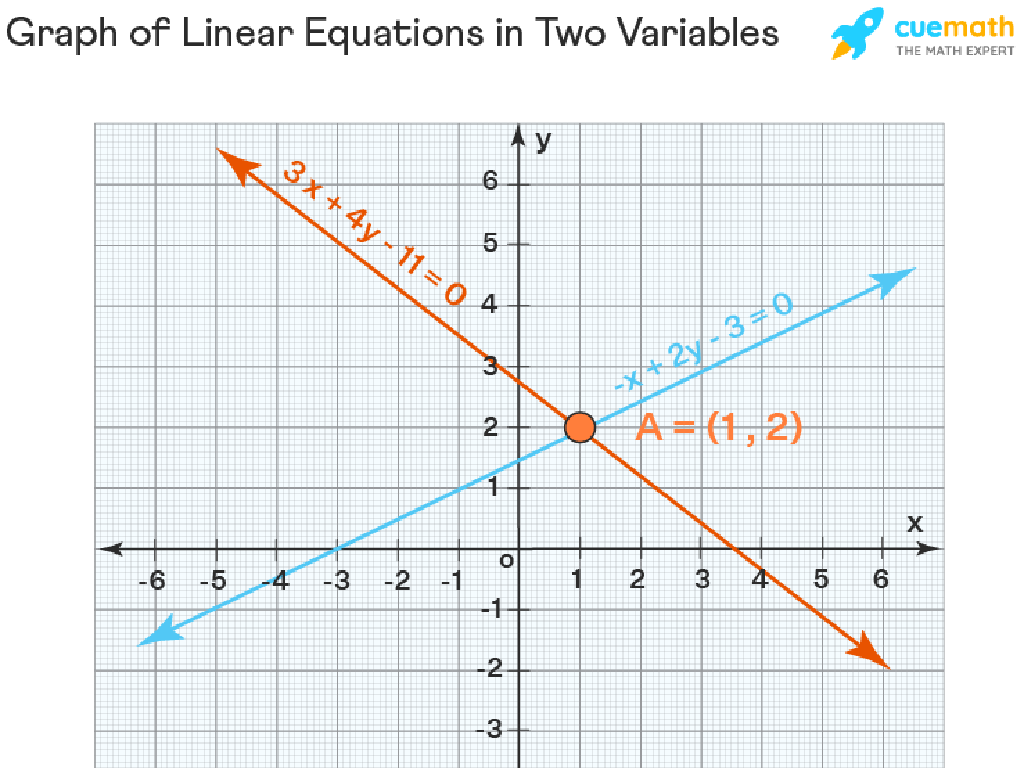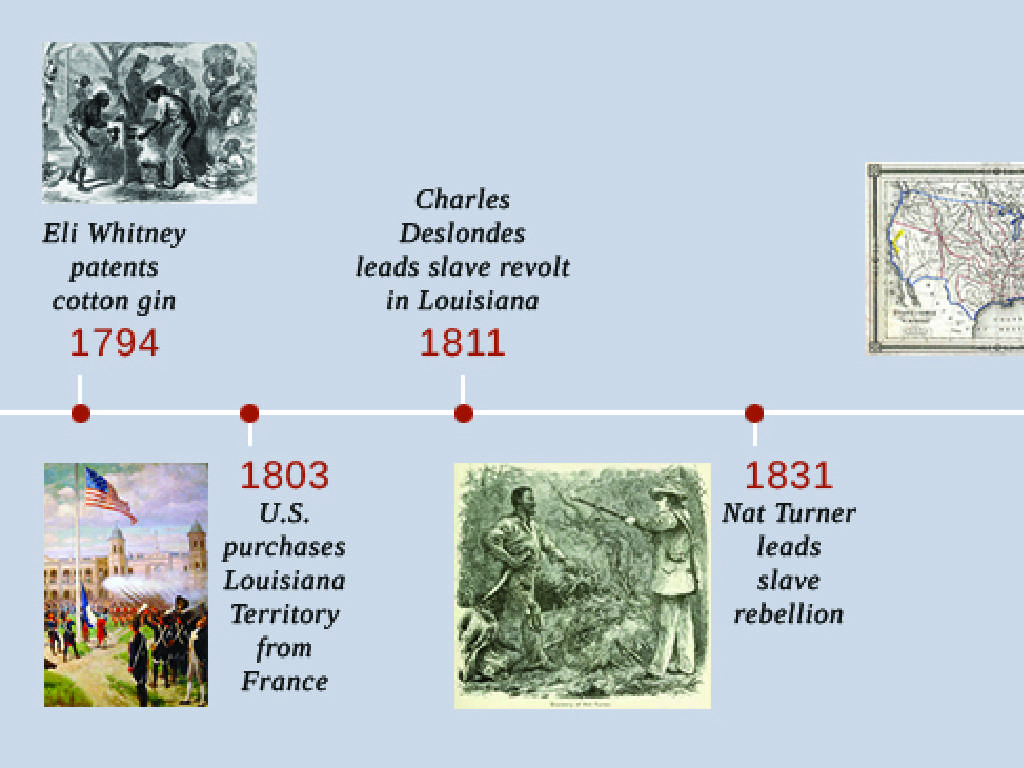Pythagorean Theorem: Word Problems
Subject: Math
Grade: Eighth grade
Topic: Pythagorean Theorem
Please LOG IN to download the presentation. Access is available to registered users only.
View More Content
Exploring the Pythagorean Theorem
– Welcome to Geometry’s foundation
– Grasping the Pythagorean Theorem
– A^2 + B^2 = C^2, where C is the hypotenuse
– The theorem’s real-world use
– Used in construction, navigation, art
– Solving practical problems
– Example: Find the ladder length to reach a 10ft high wall, 6ft away.
|
This slide introduces students to the Pythagorean Theorem, a fundamental concept in geometry. Start by welcoming students to the exciting world of geometry and then explain the theorem itself, emphasizing that it applies to right-angled triangles. Highlight how the theorem is not just a theoretical concept but is widely used in various real-life scenarios such as construction, navigation, and even art. To make the theorem more relatable, present a word problem involving a ladder leaning against a wall, where students can apply the theorem to find the length of the ladder. This practical application helps students understand the value of the theorem beyond the classroom.
Understanding Right-Angled Triangles
– Identify the right angle
– Look for the 90-degree angle in the triangle
– Name the triangle sides
– Hypotenuse is opposite the right angle, other sides are opposite and adjacent
– Relationship of triangle sides
– The sum of squares of opposite and adjacent sides equals the square of the hypotenuse
– Pythagorean theorem application
– Use a^2 + b^2 = c^2 to solve problems
|
This slide introduces students to the fundamental concepts of right-angled triangles, crucial for understanding the Pythagorean theorem. Start by identifying the right angle, which is always 90 degrees. Explain the naming of sides: the longest side opposite the right angle is the hypotenuse, while the other two sides are referred to as opposite and adjacent. Emphasize the relationship between the sides: the square of the hypotenuse equals the sum of the squares of the other two sides. This is the basis for the Pythagorean theorem, which students will apply to solve word problems. Provide examples to illustrate these concepts and prepare students for practical applications in the following lessons.
Understanding the Pythagorean Theorem
– The Pythagorean Theorem formula
– a^2 + b^2 = c^2, where c is the hypotenuse
– Variables a, b, and c explained
– a and b are legs of a right triangle, c is the longest side
– Brief overview of the theorem’s proof
– Proof connects algebra and geometry concepts
– Application in word problems
|
This slide introduces the Pythagorean Theorem, a fundamental concept in geometry that relates the lengths of the sides of a right triangle. The formula a^2 + b^2 = c^2 is the cornerstone of the theorem, where ‘a’ and ‘b’ represent the lengths of the legs, and ‘c’ is the length of the hypotenuse. It’s crucial to emphasize that this relationship only holds for right-angled triangles. Provide a brief explanation of the proof to show the theorem’s validity, which can involve a visual demonstration using squares on the sides of a right triangle. Encourage students to think about how this theorem is applied in solving real-world problems, such as finding the distance between two points or determining the height of an object without measuring it directly. The goal is for students to understand the theorem conceptually and be able to apply it to solve word problems.
Applying the Pythagorean Theorem
– Use theorem to find side lengths
– Solve for the hypotenuse
– If a and b are legs, c is hypotenuse: c = (a² + b²)
– Solve for a leg with hypotenuse known
– Given c and a, find b: b = (c² – a²)
– Practice with word problems
– Apply in real scenarios, e.g., finding ladder length
|
This slide introduces the practical application of the Pythagorean theorem in solving word problems. Start by explaining that the theorem can be used to find missing side lengths in right-angled triangles. Emphasize that ‘c’ represents the hypotenuse, the longest side opposite the right angle, and ‘a’ and ‘b’ are the other two sides. Show how to rearrange the theorem to solve for a leg when the hypotenuse and one leg are known. Provide examples such as calculating the length of a ladder needed to reach a certain height when the distance from the wall is known. Encourage students to set up equations based on the given information and solve for the unknown side. Include practice problems that involve real-life situations to help students understand the theorem’s relevance.
Solving Word Problems with the Pythagorean Theorem
– Read the problem carefully
– Understand what the problem is asking for
– Identify known and unknown values
– Look for given lengths and the length you need to find
– Set up the Pythagorean equation
– Use a^2 + b^2 = c^2, where c is the hypotenuse
– Solve for the unknown value
– Calculate the missing side using algebra
|
This slide is aimed at guiding students through the process of solving word problems involving the Pythagorean theorem. Start by reading the problem thoroughly to understand the scenario. Next, identify which values are provided and which one is the unknown that needs to be solved for. Then, set up the equation based on the Pythagorean theorem, a^2 + b^2 = c^2, where ‘a’ and ‘b’ are the legs of the right triangle and ‘c’ is the hypotenuse. Finally, solve for the unknown value using algebraic methods. Encourage students to practice with different problems and to always check their work by plugging the found value back into the equation to ensure it satisfies the theorem.
Solving Pythagorean Theorem Word Problems
– Follow a step-by-step problem-solving guide
– Identify the right triangle, list known sides, apply a^2 + b^2 = c^2
– Verify answers for accuracy
– After calculating, plug values back into the theorem to check
– Learn tips to avoid common errors
– Don’t mix up hypotenuse with other sides, ensure square units match
– Practice with example problems
|
This slide aims to equip students with a structured approach to tackle word problems involving the Pythagorean theorem. Start by reading the problem carefully and drawing a diagram if necessary. Identify the right-angled triangle and label the sides. Use the theorem a^2 + b^2 = c^2 to find the missing side. After finding the answer, it’s crucial to check the work by substituting the values back into the theorem to see if the equation holds true. Highlight common mistakes such as confusing the hypotenuse with the other sides and remind students to keep units consistent. Provide practice problems for students to apply these steps and tips, reinforcing their learning.
Pythagorean Theorem: Practice Problems
– Find a triangle’s missing side
– Use a^2 + b^2 = c^2 to solve for the missing side
– Length of ladder required
– Apply the theorem to find the ladder length for safe reach
– Diagonal of a rectangle
– Calculate diagonal using the sides as a and b
– Solve real-world problems
|
This slide presents practical applications of the Pythagorean theorem through word problems. Example 1 will demonstrate how to find a missing side of a right-angled triangle, reinforcing the a^2 + b^2 = c^2 formula. Example 2 involves determining the length of a ladder needed to reach a certain height, a common real-life application. Example 3 will show how to calculate the diagonal of a rectangle, which is useful in fields like carpentry and design. Encourage students to set up equations based on the given information and solve for the unknown. Provide guidance on how to identify right-angled triangles in various contexts and how to apply the theorem accordingly. Prepare additional problems for students to practice and ensure they understand how to translate word problems into mathematical equations.
Class Activity: Triangle Challenge
– Form small groups for problem-solving
– Use rulers to draw right triangles
– Use string to visualize triangle sides
– Apply Pythagorean Theorem for missing sides
– If a triangle has sides ‘a’ and ‘b’ as legs and ‘c’ as the hypotenuse, then a^2 + b^2 = c^2
|
This class activity is designed to reinforce the concept of the Pythagorean Theorem through hands-on learning. Divide the class into small groups and provide each with a set of triangle problems. Each group will use rulers to draw right-angled triangles on paper and strings to represent the sides, which helps in visualizing the concept. Students will then apply the Pythagorean Theorem to find the lengths of missing sides. Ensure that each group understands that the theorem only applies to right-angled triangles. As a teacher, circulate to provide guidance and ensure that students are correctly applying the theorem. Possible variations of the activity could include finding the hypotenuse given the legs, one leg given the hypotenuse and the other leg, or even creating word problems for peers to solve.
Pythagorean Theorem: Conclusion and Recap
– Recap of Pythagorean Theorem
a² + b² = c², where c is the hypotenuse
– Theorem’s significance in problem-solving
Essential for geometry, construction, navigation
– Encourage home practice
Solving different problems strengthens skills
– Confidence in applying the theorem
|
This slide aims to consolidate the students’ understanding of the Pythagorean Theorem. Begin by reviewing the theorem itself, emphasizing the formula a² + b² = c², and ensuring students can identify the hypotenuse. Discuss the theorem’s importance in various real-world applications, such as in architecture, navigation, and even sports. Encourage students to practice with additional problems at home to reinforce their learning and build confidence. Provide a list of resources or a worksheet with various word problems for them to solve. Remind them that mastering this theorem will greatly enhance their mathematical problem-solving skills.






